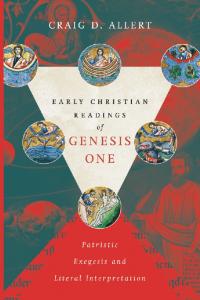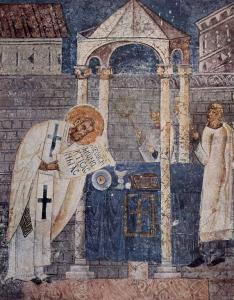 Craig Allert is leading us through a careful consideration of the early church fathers and their interpretation of Genesis One. The most important guidelines are to (1) read the writings in their context and (2) avoid the temptation to proof-text. Reading in context means three things: the context of the work being read, the context of the author’s larger body of work, and the context of the christian and broader culture in which the author writes. The temptation to proof-text is one of the sins of the modern church, one that almost always misreads the passage in question – whether the bible, other Christian writings, or the scientific literature.
Craig Allert is leading us through a careful consideration of the early church fathers and their interpretation of Genesis One. The most important guidelines are to (1) read the writings in their context and (2) avoid the temptation to proof-text. Reading in context means three things: the context of the work being read, the context of the author’s larger body of work, and the context of the christian and broader culture in which the author writes. The temptation to proof-text is one of the sins of the modern church, one that almost always misreads the passage in question – whether the bible, other Christian writings, or the scientific literature.
Basil of Caesarea (329-379) is often held up as a defender of the literal interpretation of Scripture and an opponent of allegory. His homilies in the Hexaemeron on Genesis 1 are seized upon as ancient support for modern young earth creationism and the “literal” interpretation of these passages. Basil certainly does argue against certain kinds of allegory – but to understand his arguments we really need to understand the alternative views. While it is common to think that he has the allegorizing of Origen in view, Allert argues that this is almost certainly mistaken. In fact, taking the work of Basil as a whole, he generally follows the three-fold method of Origen while not agreeing with all of his conclusions. Basil introduced an innovation into the Eastern church with the doxology – Glory to the Father, and to the Son, and to the Holy Spirit. This was felt by some to be an unbiblical extrapolation. In response Basil wrote a treatise On the Holy Spirit, from which Allert notes:
Basil is quite clear about the danger of an overly literal reading of Scripture, explaining why he believes this near the beginning of the treatise: “The petty exactitude of these men about syllables and words is not, as might be supposed, simple and straightforward; nor is the mischief to which it tends a small one. There is involved a deep and covert design against true religion.” Thus, even though these critics wanted biblical language and only explicit biblical teaching included in Basil’s doxology, he argues that they were actually battling against Scripture. (p. 171)
 In his commentaries on the Psalms, Basil also uses figurative or allegorical interpretations. Allert mentions explicitly Psalm 28 (p. 173) and alludes to several others. In the Hexaemeron, Basil uses both literal and figurative or allegorical readings. Allert outlines three ways Basil interprets Genesis 1 in ways other than literal.
In his commentaries on the Psalms, Basil also uses figurative or allegorical interpretations. Allert mentions explicitly Psalm 28 (p. 173) and alludes to several others. In the Hexaemeron, Basil uses both literal and figurative or allegorical readings. Allert outlines three ways Basil interprets Genesis 1 in ways other than literal.
First, “Basil compares natural phenomena with human situations for the purpose of moral lessons.“ (p. 177) For example:
He explains that there is a “hidden reason” for the varied shape of the moon: “In truth, it is so as to provide for us a clear example of our nature. For, nothing human is stable.” Thus, the moon actually teaches us about our own vicissitudes, and because of that, we should be wary of pride in our successes, power, and wealth. In the flesh there is constant change, so one should care for the soul, “whose good is unchangeable.” The moon is then compared to the human soul. One who is troubled that the moon diminishes its splendor in its waxing and waning should be distressed much more so by the soul, which “having possessed virtue, through neglect destroys its beauty and never remains in the same disposition, but turns and changes constantly through fickleness of mind.” (p. 175)
One could argue that this is an extrapolation not an interpretation – but it remains true that Basil does not limit the message to the literal meaning alone.
Second, he calls his listener to a deeper meaning. He reads into the text of Genesis 1 the presence of the Son (and possibly the Spirit) at creation.
The passage, according to Basil, shows that God not only wanted creation accomplished but also brought it forth through a coworker. … by indicating God as speaking and commanding, “it indicates silently Him to whom He gives the command and to whom He speaks, not because it begrudges us the knowledge, but that it may inflame us to a desire by the very means by which it suggests some traces and indications of the mystery.” He continues with the explicit claim that in these passages Scripture leads us, in an orderly way, to the “idea of the Only-begotten.” “This way of speaking has been wisely and skillfully employed so as to rouse our mind to an inquiry of the Person to whom in these words are directed.”Apparently for Basil, a reading according to common use includes searching for “indications of the mystery.” In this case, the mystery is the agency of Christ in the creation. (p. 178)
A deeper reading, finding Christ in the text, was a common approach in the early church.
Finally, “he uses explicit spiritualization or allegorization.“ (p. 181) The fruit bearing trees of Genesis 1:11 are likened to human souls through connection with the vine and vineyard references in the New Testament. The light from the sun is likened to the true light of the world. Allert asks:
In what sense can either of these two examples from the Hexaemeron be called a “literal” reading? Is Basil’s explanation of the vine, based on the trees in Genesis 1:11, a reading that is accurately described as plain? Does Basil’s move from the creation of light, and then the sun, to participation in the true Light of the world lead us to agree … that Basil advocated and exemplified a humble acceptance of the “common sense” of Genesis? Again, what kind of reading of Scripture is this – literal or allegorical? (pp. 183-184)
What then are we to make of the passages in the Hexaemeron where Basil argues for literal against allegorical meanings? For example 9.1:
I know the laws of allegory, though less by myself than from the works of others. There are those truly, who do not admit the common sense of the Scriptures, for whom water is not water, but some other nature, who see in a plant, in a fish, what their fancy wishes, who change the nature of reptiles and of wild beasts to suit their allegories, like the interpreters of dreams who explain visions in sleep to make them serve their own ends. For me grass is grass; plant, fish, wild beast, domestic animal, I take all in the literal sense. “For I am not ashamed of the gospel.” Those who have written about the nature of the universe have discussed at length the shape of the earth. If it be spherical or cylindrical, if it resemble a disc and is equally rounded in all parts, or if it has the forth of a winnowing basket and is hollow in the middle; all these conjectures have been suggested by cosmographers, each one upsetting that of his predecessor. It will not lead me to give less importance to the creation of the universe, that the servant of God, Moses, is silent as to shapes; … It is this which those seem to me not to have understood, who, giving themselves up to the distorted meaning of allegory, have undertaken to give a majesty of their own invention to Scripture. It is to believe themselves wiser than the Holy Spirit, and to bring forth their own ideas under a pretext of exegesis. Let us hear Scripture as it has been written. (NPNF 2.08 pp. 101-102 – Allert uses a different translation, this is the one I have at my fingertips.)
 Does this passage along with a few others imply a literal reading of the creation passage? In a sense it does – but the argument is not for scientific knowledge in the text. Rather, it is in favor of reading scripture for its intended meaning (in light of Christ) rather than as a repository of codes and such. In fact, Allert suggest that Basil is responding to a view out there in his cultural environment that interpreted creation in a mystical-philosophical sense. The idea that evil that opposes God exists independent of God was ‘out there’ – as was a view of matter as less than good. Consider Genesis 1:2 “darkness was over the surface of the deep” and 1:6-7 “And God said, “Let there be a vault between the waters to separate water from water.” So God made the vault and separated the water under the vault from the water above it. And it was so.” These passages were being interpreted in mystical and damaging ways. Allert writes:
Does this passage along with a few others imply a literal reading of the creation passage? In a sense it does – but the argument is not for scientific knowledge in the text. Rather, it is in favor of reading scripture for its intended meaning (in light of Christ) rather than as a repository of codes and such. In fact, Allert suggest that Basil is responding to a view out there in his cultural environment that interpreted creation in a mystical-philosophical sense. The idea that evil that opposes God exists independent of God was ‘out there’ – as was a view of matter as less than good. Consider Genesis 1:2 “darkness was over the surface of the deep” and 1:6-7 “And God said, “Let there be a vault between the waters to separate water from water.” So God made the vault and separated the water under the vault from the water above it. And it was so.” These passages were being interpreted in mystical and damaging ways. Allert writes:
He states that darkness is taken in this verse to indicate an evil that opposes God. “If ‘God is light’ (1 Jn 1:5) they say, assuredly in conformity with the meaning, the power warring against Him would be darkness, a darkness not having its being from another, but a self-begotten evil.” Basil opposes this interpretation, not because it is allegorical in nature but rather because it would mean that darkness subsisted on its own and had not been made by God. This is why Basil, in this instance, claims that the meaning of this phrase is “simple and easily understood by all” and invites his listeners to “accept the concept of darkness simply and without curiosity.” (p. 201)
Earlier in the chapter Allert deals with Basil’s reaction to misinterpretations of verses 6-7
The allegorization to which he objects is of the water under the heaven meaning “spirits of malice.” These spirits who fell are called “sea” because of their unstable and inconsistent movements. It is these kinds of meanings that are “dream interpretations and old women’s tales.” It was popular in Neoplatonic circles to associate demons with the movements of the sea. (p. 187)
What does this mean? Basil does object to fanciful allegorization especially when it misinterprets the whole scheme of the world. He did not take a rigorously literal approach to Scripture, and in fact argued against such an approach when it placed God in the same plane of existence as humans, limited by the created world. “The issue appears not to be either allegorical or literal interpretation. Rather, there are other factors at work in determining how one ought to interpret. ….Basil saw heretical, figurative interpretations as a threat to his common audience because they could not discern them.” (p. 202)
To use proof texts from the Hexaemeron of Basil of Caesarea to demonstrate a long line of interpretation consistent with the modern fundamentalist approach is simply inconsistent with his reasoning and writing. Basil was responding to issues of his day, in ways appropriate for his audience. He was not addressing our specific concerns – although there is much that we can learn from him even today.
All in all, a very interesting chapter in Early Christian Readings of Genesis One (with far more detail than my short interaction covers).
If you wish to contact me directly you may do so at rjs4mail[at]att.net.
If interested you can subscribe to a full text feed of my posts at Musings on Science and Theology.















